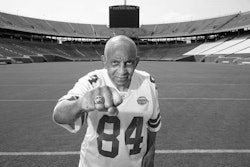On November 26, 2012, Jon Embree’s emotions and character were on display for all to see. After a dismal 1-11 season, which included several embarrassing losses such as a 70-14 drubbing at the hands of the Oregon Ducks, the University of Colorado held a press conference announcing that Embree had been fired as the head coach of the football team.
Embree, a former standout tight end with the Buffaloes in the late 1980s, was emotional and tearful, but also reminded his players of their successes. With Embree as coach, the team had its highest three consecutive semester grade point averages in the history of the program. In addition, Embree stemmed the tide of criminal, violent, and drug-related incidents and arrests that had occasionally overshadowed the play on the field the last decade.
Elevating the academic and moral standards of one of the school’s most visible entities, however, wasn’t enough for Embree to be retained after a 4-21 record over the last two seasons. Embree remarked that being fired “stinks,” but given his lack of victories on the field, he understood.
Inadvertently, Embree also pointed out something else foul. When asked if he would coach again, Embree noted that African-Americans do not usually obtain a second opportunity to coach a major football program. Embree’s comments have since opened a dialogue on the head coaching opportunities for Blacks in college football. Of the 41 Blacks hired as head coaches of major college football programs since 1979, only one has gotten a second opportunity to lead another major program.
The fact highlights the need for a “Robinson Rule,” as Floyd Keith, executive director of Black Coaches and Administrators (BCA), terms it. Named after Eddie Robinson, the former Grambling State University football coach who is second in total victories in NCAA football history, the rule, similar to the NFL’s “Rooney Rule,” would mandate that minorities be interviewed for certain coaching and athletic administrative positions. Advocates argue that the rule is particularly necessary in college football, where minorities hold only 20 of the 120 head coaching posts at major programs. That statistic is galling considering that, in 2011, African-Americans made up 46 percent of student-athletes in major college football and have made up more than 39 percent since 1999. Yet, minorities have never held more than 17 percent of head coaching positions in the sport.
The situation suggests the once common sports refrain that Blacks have the brawn to play the game, but not the brains to coach it. The Rooney Rule improved coaching opportunities for minorities in the NFL. Since its implementation in 2003, the percentage of African-American head coaches has increased from 6 percent to 22 percent.
The BCA suggests that the lack of head coaching opportunities for African-Americans in college football stems from the dearth of opportunities they have in intercollegiate athletic administration. Few minorities obtain opportunities as head coaches because so few are interviewed. According to the Institute for the Diversity and Ethics in Sports at the University of Central Florida, 76 percent of school presidents and 84 percent of athletic directors, those who hire coaches, are White males.
Consequently, the proportion of minority coaches to minority athletes in all NCAA sports continues to lag. The BCA suggests that a Robinson Rule be mandated for athletic administration positions as well. One can only hope that the rule would mandate that women also be interviewed for these positions. The application of the Rooney Rule to senior administrative positions in NFL franchises in 2009 is already being credited with creating diversity in several teams’ front offices.
Intercollegiate athletics have long been congratulated for their progressiveness on issues of race. Yet, the altruism associated with integration on the field and court, as several scholars and critics have pointed out, has often been used to mask some of college sports’ other questionable values such as the continued gap in graduation rates between White and minority athletes.
At best, Embree’s press conference raised awareness of an issue that the NCAA and its member institutions will address as progressively as their reputation suggests. Even if legislated, however, a Robinson rule should be considered another step forward in progress and not a total solution.
Embree’s comment that Black coaches generally get only one shot at the big-time, while more of their White colleagues obtain multiple opportunities, is reminiscent of sports reporter Jack Olsen’s lament that there was nothing sadder than stumbling upon a discarded Black student-athlete. It was typical in the 1960s, Olsen reported, for many schools to recruit Blacks to bolster their football and men’s basketball programs, the two major revenue-producing sports. Many were usually kept eligible for sports participation through Mickey Mouse courses that did not count toward their degrees. After exhausting their eligibility and with few avenues to continue their education, they were turned out into the streets if they were not one of the few fortunate to earn a professional contract.
Although the graduation rates of Black athletes have increased markedly since then, Embree’s press conference suggested that Olsen’s figure of the tragic Black student-athlete has company. Turned out from his head-coaching job, despite his notable work off the field, Embree teared up on the thought of never returning. It will take more than a Robinson Rule to challenge the winning-at-all-cost that continues to pervade college sports.
Dexter L. Blackman is a associate professor of history and African American Studies at Loyola Marymount University and has written frequently on the social meaning of African American sports participation.


















